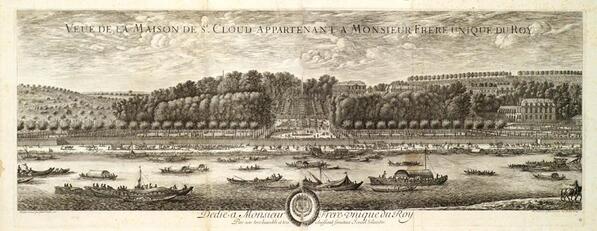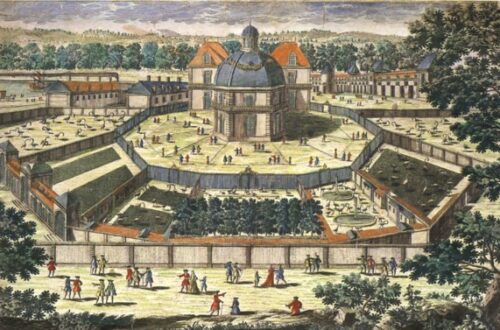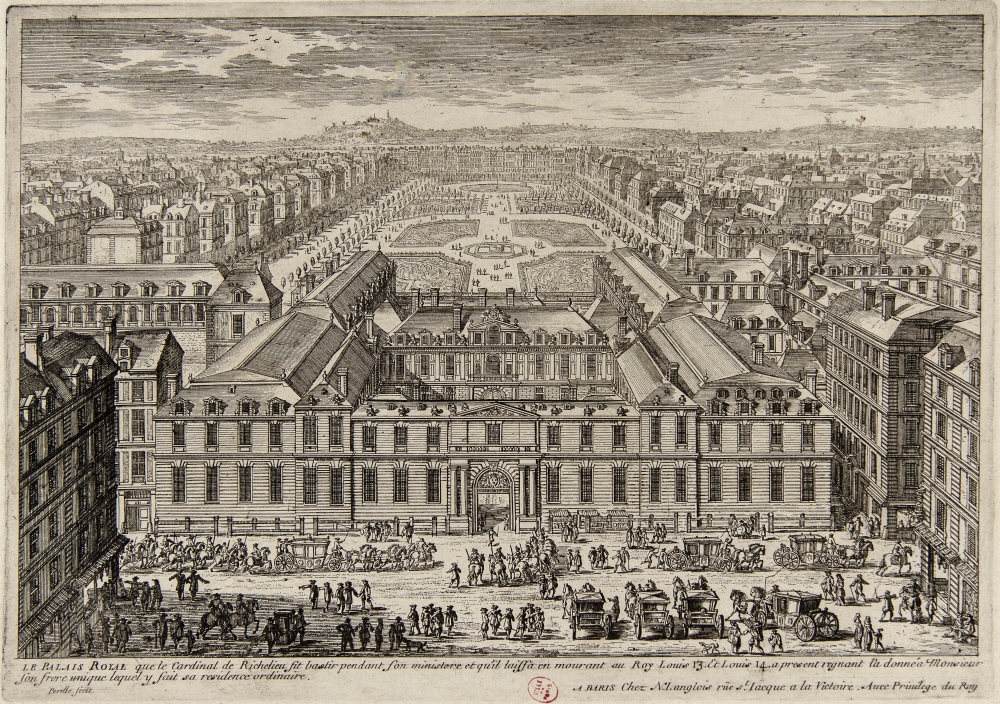The château de Marly and the “les Marlys”
In 1676, before the court moved to Versailles and while Versailles was a big construction side, Louis XIV bought two estates not too far away for another large building project… which would become a château of which many said it outshone Versailles.
 The Sun King bought two ancient seigneuries -fiefs- called Marly-le-Chastel and Marly-le-Bourg, located between Versailles and Saint-Germain-en-Laye in a sort of green haven. There was a nice view, thick forests for hunting and a good access to water in order to create a grand garden. Louis could not have wished for a better location and thus the whole area, including the village of Marly, was renamed Marly-le-Roi.
The Sun King bought two ancient seigneuries -fiefs- called Marly-le-Chastel and Marly-le-Bourg, located between Versailles and Saint-Germain-en-Laye in a sort of green haven. There was a nice view, thick forests for hunting and a good access to water in order to create a grand garden. Louis could not have wished for a better location and thus the whole area, including the village of Marly, was renamed Marly-le-Roi.
The architects Jules Hardouin-Mansart and Robert de Cotte were employed to design a little pleasure château for Louis in 1679. The plans being drawn up, the builders Jean Bailly and François Lespée were entrusted to act them out. They signed the building contract on 22 February in 1680.
Instead of building one big connected château, a la Saint-Cloud, it was decided to build a central pavilion flanked by twelve smaller pavilions, six on each side, which all had access to the garden and were pretty much surrounded by baroque nature. Mansart was inspired by Charles Le Brun’s paintings and wanted the place to look a bit like it was a huge and perfect painting, full of Olympian symbolism that Louis XIV loved so much.
The central pavilion, called pavillon-royal or pavillon du roi, was built on an esplanade and its decor all about Apollo and Thetis. It featured a large octagonal Italian-style salon, nearly 15 meters high, which was flanked by four vestibules connecting the salon to the living quarters of the royal family. Next to the King and Queen, Monsieur and Madame had apartments in this pavilion. Louis XIV’s apartment was located in such a way, that it pointed towards Saint-Germain-en-Laye, the place of his birth.
With its Apollo theme, the pavillon du roi formed the centre of the whole place, aka the Sun, while the twelve smaller pavilions flanking it represented the twelve zodiacal signs revolving around the supreme star. Those pavilions were dedicated to other Olympian Gods and also to Hercules, Victory, Fame and Abundance. To save a bit of money, the facades were painted by Le Brun, who added trophies, bas-reliefs and artificial pilasters to make them a bit more lively. The whole pavilion idea and arrangement quickly became a fashion in all of Europe for hunting and pleasure châteaux.
The Sun King visited Marly for the opening of the completed hydraulic system on 23 July in 1684 and was utterly taken at once. “J’ai fait Versailles pour ma Cour, Trianon pour ma famille, Marly pour mes amis.” Marly quickly became his favourite place, although it took until 1686 for the construction works to allow him to spend a night there.
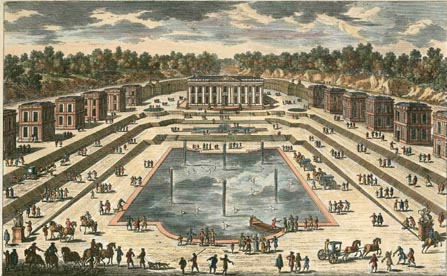
To quote Louis XIV, Marly was for his friends. For that very reason everything there was quite small for a royal residence. The number of “friends” to join the Sun King at Marly was limited and during the day the twelve pavilions were public places. Meaning every one of the guests could enter them and decide to play cards in one of them, even if it was not the one in which the person stayed during the night. This also meant that the very strict rules of etiquette of Versailles could not be applied to Marly. There was simply not enough space for it. Thus Marly’s etiquette was less stiff and things which were impossible at Versailles, were very possible there. Louis XIV, the inventor of the etiquette, actually enjoyed this a lot and the older he got, the more often he came to Marly.
The limited space and limited number of guests made becoming one of those invited to Marly the most sought thing at court. Everyone could go to Versailles, that took nothing. Even the non-nobility, if dressed proper, could enter Versailles… but Marly… one had to be very special in the eyes of the King to gain access there. Even the Princes du Sang could not simply go to Marly without invitation. So, being one of the Marlys, the lucky few who had received an invitation or were granted permission to join the King without needing an invitation for every trip, was a privilege everyone wanted. It were only between sixty and one-hundred people, never more, compared to the thousands roaming Versailles.
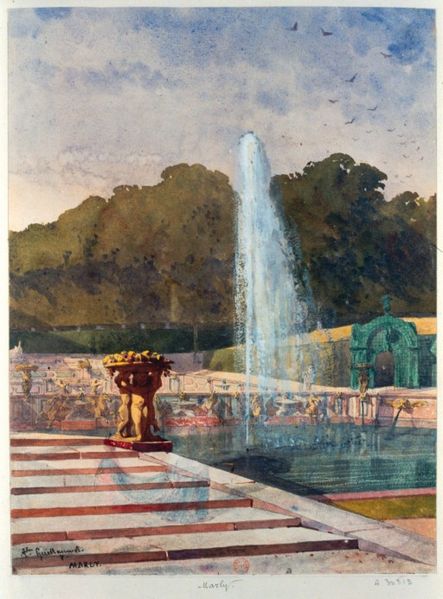 The jardins du Marly were a marvel. The whole place was surrounded by large shady trees, bosquets of flowers, basins with fountains and especially created viewpoints flanked by marble statues. Louis also finally got himself a grande cascade, he always wanted one since he saw that of Saint-Cloud, but creating it at Versailles, a rather flat area, did not quite work. And to make it easier for the ladies, he ordered wide straight roads to be created in the thick forest. That way, the ladies could follow the hunt easier in their carriages.
The jardins du Marly were a marvel. The whole place was surrounded by large shady trees, bosquets of flowers, basins with fountains and especially created viewpoints flanked by marble statues. Louis also finally got himself a grande cascade, he always wanted one since he saw that of Saint-Cloud, but creating it at Versailles, a rather flat area, did not quite work. And to make it easier for the ladies, he ordered wide straight roads to be created in the thick forest. That way, the ladies could follow the hunt easier in their carriages.
Louis XIV’s successor Louis XV was unfortunately not very interested in Marly. His successor Louis XVI was not more interested, but did spent some time there with his wife Marie-Antoinette. During the Revolution, Marly was abandoned and pillaged. Many of the large marble statues were brought away. The famous Chevaux de Marly were brought to Paris to flank the opening of the Champs-Élysées. In 1799 or 1800, Marly-le-Roi was sold to an industrialist called Monsieur Sagniel, who installed machines for cotton-spinning there. His industry failed, so the whole château was taken apart and sold piece by piece. Napoleon bought what was left back and it today belongs to the State.
What remains today are small parts of the garden and its water basins as well as some of the foundations. Many of the statues luckily found a new home by now, the Cour Marly of the Louvre, where many of them are on display in a very impressing arrangement.



